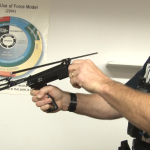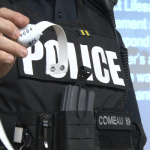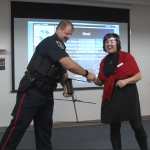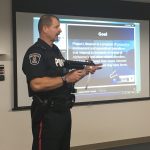Project Lifesaver comes to Belleville to help people at risk of wandering
BELLEVILLE – A much-anticipated device to help people at risk of wandering away from safety has arrived in Belleville.
Project Lifesaver is a joint project between the Belleville police and the Hastings-Prince Edward Alzheimer’s Society. The device is used to track people who have Alzheimer’s, autism and Down Syndrome if they wander off.
The executive director of the Alzheimer’s society, Maureen Corrigan, said that about 60 per cent of people diagnosed with Alzheimer’s will eventually start to wander. That’s where Project Lifesaver comes into play.
At a press conference on Tuesday Const. Pat Comeau of the Belleville police demonstrated how the officers will use the device. The patient wears a bracelet that looks a lot like a watch. If they are reported missing, officers can track them thanks to a signal from the bracelet, using an antenna mounted on the police car. When the antenna picks up the signal, the officer gets out of the car and turns on a receiver. It tells the officer which direction the lost person has gone in. The closer the officer gets, the louder it beeps.
Half of the people not found within 24 hours of wandering off are at risk of serious injury or even death, according to the Alzheimer’s Society. With Project Lifesaver, it takes just under 30 minutes to find the person at risk.
Corrigan said there have been people in Belleville waiting to be able to use this device.
“Some of our clients have already been asking for this for about a year or so, because it has been in Quinte West for about a year and a half or two years now. It’s just another program that we’re allowed to offer. So that’s pretty exciting,” she said.
Comeau said that two officers from each of the four platoons will be fully trained to operate the device.
The device is fantastic to have and use because there is a problem with people wandering away from safety in this area, he said.
“As our population starts to rise, we have more people who are prone to dementia, and therefore a lot of our resources are allocated towards that. Not that there is an issue with the resources, but we want to be able to find them faster and more efficiently so that people don’t get hurt.”
On average, a person can walk six kilometres in one hour. In that time it is not hard for someone to wander deep into a forest, Comeau said.
“This will allow us to find them very quickly, and therefore there are not in a position where they’re out in the cold or unable to be found because they have gone into a culvert or into the water or into thick brush.”
Corrigan told QNet News that the Project Lifesaver program is just one component of the society’s program called Finding Your Way.
The society “offers free education and support for persons with dementia and their care partners,” she said. “This is just one of the many things that we offer, but we’ll do education and training, for emergency response people but also for people in the community. Everyone should get involved, because the more people that know how to keep someone safe, recognize the warning signs of someone who is disoriented or lost, the better chance we have at keeping all of our community safe.”
The wristband costs $350, and users also pay a $50 administration fee and a $20 fee to change the batteries every two months. Corrigan said that if a family needed help with the purchase cost, the organization would look at assisting them.
 Print This Post
Print This Post










